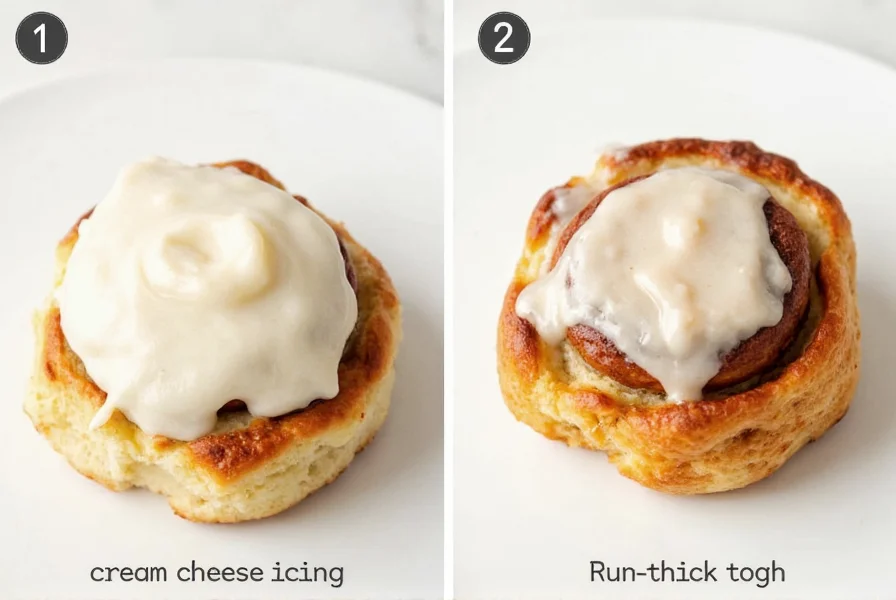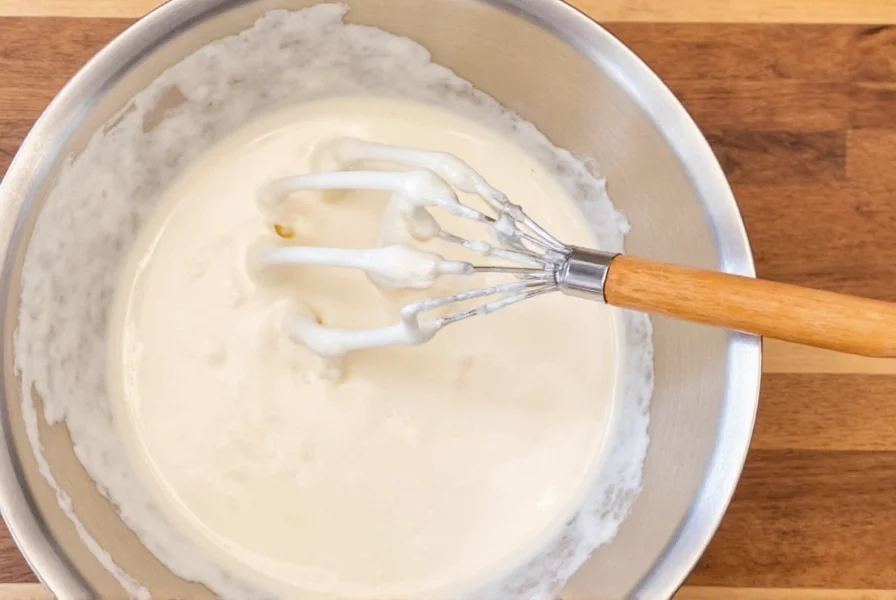Nothing completes a batch of freshly baked cinnamon rolls like the perfect icing. While some prefer a simple powdered sugar glaze, cream cheese icing offers that ideal balance of richness and tang that cuts through the sweetness of the rolls. After testing dozens of variations in my kitchen over 15 years of baking, I've perfected a foolproof cream cheese icing recipe that maintains its structure without becoming runny or overly sweet.
The Essential Cream Cheese Icing Recipe
This tried-and-true cream cheese icing recipe yields enough to generously cover 12-16 standard cinnamon rolls. The key is using ingredients at proper temperatures and following the mixing sequence precisely.
| Ingredient | Measurement | Preparation Notes |
|---|---|---|
| Cream cheese | 4 oz (113g) | Full-fat, softened to room temperature |
| Unsalted butter | 1/2 cup (113g) | Softened to room temperature |
| Powdered sugar | 2 cups (240g) | Sifted, not packed |
| Vanilla extract | 1 tsp | Pure, not imitation |
| Salt | Pinch (1/16 tsp) | Enhances flavor balance |
Step-by-Step Instructions
- Cream the base: In a medium bowl, beat softened cream cheese and butter together until completely smooth and no lumps remain (about 2 minutes with hand mixer)
- Add dry ingredients: Gradually incorporate sifted powdered sugar, about 1/2 cup at a time, mixing on low speed to prevent sugar clouds
- Finish with flavor: Mix in vanilla extract and salt until fully combined. Do not overmix once sugar is incorporated
- Adjust consistency: If too thick, add 1 tsp milk or cream; if too thin, add 2-3 Tbsp additional powdered sugar
- Application: Spread immediately on slightly cooled cinnamon rolls (warm but not hot) using an offset spatula

Why This Cream Cheese Icing Recipe Works
The science behind perfect cinnamon roll icing comes down to ingredient ratios and temperature control. Many home bakers struggle with icing that's either too runny or becomes grainy. This recipe solves both problems through precise measurements and proper technique.
Cream cheese provides the signature tang that balances the sweetness, while the 2:1 ratio of powdered sugar to dairy creates structure without excessive sweetness. The small amount of salt is crucial—it doesn't make the icing salty but enhances all the flavors and prevents that one-note sweetness that characterizes inferior frostings.
Temperature matters more than most realize. Ingredients at room temperature (68-72°F) emulsify properly, creating a stable mixture that won't separate. Cold ingredients lead to lumpy icing, while warm ingredients cause the frosting to become too soft and slide off the rolls.
Popular Variations for Different Preferences
While the classic cream cheese version remains the favorite for many, these tested variations accommodate different dietary needs and flavor preferences:
- Traditional Powdered Sugar Glaze: For those who prefer a simpler topping, whisk together 1 cup powdered sugar, 2 Tbsp milk, and 1/2 tsp vanilla until smooth. This easy cinnamon roll glaze recipe works well when cream cheese isn't available.
- Vegan Cream Cheese Icing: Substitute with 4 oz vegan cream cheese and 1/2 cup coconut oil (melted and cooled). Add 1 Tbsp lemon juice to mimic the tang of dairy cream cheese.
- Maple Cinnamon Icing: Replace 2 Tbsp of the powdered sugar with pure maple syrup and add 1/4 tsp cinnamon to the basic recipe for a complementary flavor profile.
Troubleshooting Common Icing Problems
Even with a perfect recipe, issues can arise. Here's how to fix the most common cinnamon roll icing problems:
| Problem | Causes | Solutions |
|---|---|---|
| Icing is too runny | Hot rolls, warm ingredients, too much liquid | Cool rolls first; add 2-3 Tbsp powdered sugar; refrigerate icing 10 minutes before applying |
| Icing is too thick | Cold ingredients, too much sugar, overmixing | Add liquid 1 tsp at a time; let sit 5 minutes to soften naturally |
| Icing becomes grainy | Undissolved sugar, temperature shock | Strain through fine mesh; ensure all ingredients at room temperature |
| Icing separates | Overmixing, temperature extremes | Refrigerate 10 minutes, then gently remix; avoid extreme temperature changes |
Pro Tips for Perfect Icing Every Time
- Timing is everything: Apply icing when rolls have cooled for 10-15 minutes—warm enough to melt slightly into the surface but not hot enough to become runny
- Storage matters: Leftover iced rolls keep best at room temperature for 24 hours; refrigerate longer storage but bring to room temperature before serving
- Flavor pairing: Add 1/4 tsp almond extract to complement the cinnamon flavor without overpowering it
- Texture control: For a thicker icing that holds decorative swirls, increase cream cheese to 6 oz and reduce powdered sugar to 1 3/4 cups

Frequently Asked Questions
Can I make cream cheese icing ahead of time?
Yes, prepare the icing up to 24 hours in advance. Store in an airtight container in the refrigerator, then bring to room temperature and re-whip for 30 seconds before using. The slight temperature adjustment may require adding 1 tsp milk to restore perfect spreading consistency.
Why does my cream cheese icing become watery on the rolls?
This happens when rolls are too hot when icing is applied. The ideal temperature for applying icing is when rolls have cooled for 10-15 minutes after baking—warm to the touch but not hot enough to create steam. If icing becomes watery, refrigerate the entire pan for 5 minutes to set the icing, then reapply a fresh layer.
How can I make my cinnamon roll icing thicker for piping decorations?
For piping consistency, increase cream cheese to 6 oz and reduce powdered sugar to 1 3/4 cups. Chill the finished icing for 20 minutes before transferring to a piping bag. This thick cream cheese frosting for cinnamon buns holds its shape beautifully for decorative swirls while maintaining the perfect flavor balance.
Can I use this icing recipe for other baked goods?
Absolutely. This versatile cream cheese icing works beautifully on carrot cake, coffee cake, and even as a filling between cake layers. For cakes requiring sturdier frosting, increase powdered sugar by 1/4 cup. The same principles of ingredient temperature and proper mixing apply regardless of application.











 浙公网安备
33010002000092号
浙公网安备
33010002000092号 浙B2-20120091-4
浙B2-20120091-4